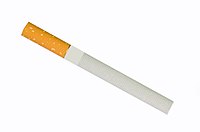
Photo from wikipedia
Oral disease is frequently associated with viral and environmental exposures and oral hygiene. The use of tobacco is a risk factor in the development of oral disease. Cytotoxicity, inflammatory response,… Click to show full abstract
Oral disease is frequently associated with viral and environmental exposures and oral hygiene. The use of tobacco is a risk factor in the development of oral disease. Cytotoxicity, inflammatory response, and oxidative stress have been reported to have a role in the development of oral disease. These three endpoints were evaluated in a 3D human oral buccal model, EpiOral™, following exposure to CORESTA reference smokeless tobacco products (CRPs) and cigarette whole smoke. CRPs for Swedish style snus (CRP1), moist snuff (CRP2), and dry snuff (CRP3) were each extracted in complete artificial saliva (CAS) with a ratio of 300 mg CRP to 1 mL of CAS. Each of the CRP extracts (15-300 mg/ml) were applied to the apical side of a 3D organotypic buccal cell model for 24 or 48 h continuously, then cytotoxicity (LDH), oxidative stress (8-isoprostane), and inflammatory response (IP10, IL-1α, and IL-8) were measured. Experiments with 3R4F cigarettes were conducted by exposing the buccal tissues to whole smoke for a maximum of 2.5 h. Cytotoxicity (MTT) was measured 24 h post-exposure. Exposure of buccal tissues to whole smoke from a cigarette induced a dose-dependent cytotoxic response. In contrast, the CRP extracts elicited minimal cytotoxicity (<15%) when compared to CAS (vehicle control), but time- and dose-dependent effects on oxidative stress and inflammatory response were observed. Collectively, these data demonstrate that a 3D organotypic buccal human model may be used to assess biological mechanisms (MOAs) involved in the development of oral disease following exposure to smokeless tobacco products and may be applicable for differentiation between tobacco product categories.
Journal Title: Toxicology mechanisms and methods
Year Published: 2021
Link to full text (if available)
Share on Social Media: Sign Up to like & get
recommendations!